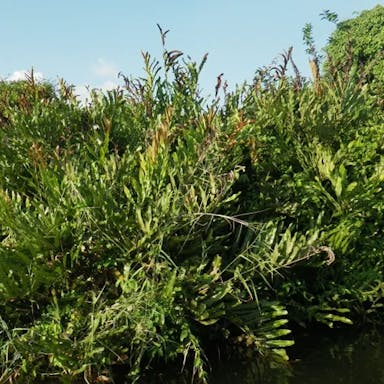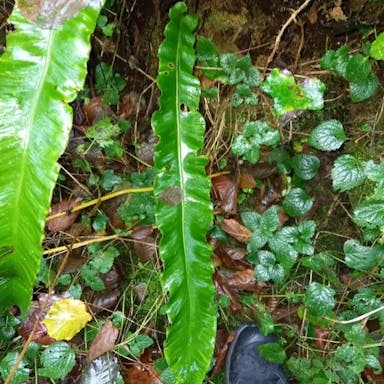The flower language commonly used in America for the Giant chain fern is resilience and strength. Examples of flower language: - Red rose: Love and passion - Sunflower: Adoration and loyalty - Lily of the valley: Happiness and purity Explaining the language of flowers: For instance, the red rose symbolizes love and passion. It is often given as a romantic gesture to express deep affection and desire.
Giant chain fern
- Scientific name
- Woodwardia fimbriata
Basic Information
- Aspleniaceae Family Woodwardia Genus Giant chain fern Species
- Aspleniaceae > Woodwardia > Woodwardia fimbriata
- 83%
- The Completeness of This Encyclopedia
Please help us complete the encyclopedia, Terrarium is a encyclopedia service to be completed with everyone in the world. Currently, this page is 83% complete. For more information on how to contribute, please click here.
- Pteridophyta
- Height
- 150cm ~
- Flower Color
- Leaf Color
- Anthesis
- Sunlight Exposure
Full Sun Long hours of sunlight from morning to afternoon Partial Shade A location in the shade of a tree or where either the morning or afternoon is shaded Full Shade A place where there is no direct sunlight
- Partial Shade
- Hardiness Zones
This is an indicator to know to which zone each plant can winter. Knowing the zone of each plant gives you an idea of the cold temperature resistance when grown in the ground without a roof. 2: -42.7 to -40.0 3: -39.9 to -34.4 4: -34.3 to -28.9 5: -28.8 to -23.3 6: -23.2 to -17.8 7: -17.7 to -12.2 8: -12.1 to -6.7 9: -6.6 to -1.1 10: -1.0 to 4.4 11: 4.5 to 10.0
- 7
- Cold resistance
- Good
- Heat resistance
- Fair
- Habitat of origin
- United States
- Growth Rate
- Normal
What is Giant chain fern (Woodwardia fimbriata)?
What is Giant chain fern (Woodwardia fimbriata)
Flower meaning
For the Giant chain fern, watering frequency should be moderate, approximately every 7-10 days during the growing season. Ensure the soil remains consistently moist but not waterlogged to prevent root rot. During the dormant season, reduce watering to every 2-3 weeks to mimic natural conditions. Check soil humidity by inserting a finger into the soil up to 2 inches deep; if it feels dry, it's time to water. Water the plant thoroughly, allowing excess water to drain out of the pot to avoid water accumulation at the roots.
Calendar of Giant chain fern (Woodwardia fimbriata)
Calendar
Giant chain fern offers two main varieties: one with fringed leaflets, known as variety A, and another with smooth leaflets, known as variety B. When selecting seedlings, look for healthy, vibrant green fronds without signs of discoloration or damage. For seeds, choose plump, firm ones that are not shriveled or discolored. Ensure seedlings have well-established root systems and are free from pests or diseases. Variety A thrives in moist, shaded areas, while variety B prefers drier, more open locations. Consider your garden conditions before making a selection.
How to grow Giant chain fern (Woodwardia fimbriata)
Watering
The Giant chain fern thrives in partial to full shade, making it ideal for areas with limited direct sunlight. It exhibits moderate cold tolerance, able to withstand temperatures as low as 20°F (-6°C). During hot summers, it benefits from protection against intense afternoon sun to prevent leaf scorching. In terms of heat tolerance, it prefers cooler temperatures and may struggle in extreme heat. The optimum temperature range for this fern is between 60-75°F (15-24°C). Over winter, it should be brought indoors or provided with additional insulation in colder climates. When placing the Giant chain fern, choose a location with filtered sunlight or dappled shade. It can handle some morning sun but should be shielded from harsh midday and afternoon rays. Ideally, it should receive 4-6 hours of sunlight per day for optimal growth.
Soil and Fertilizer
Giant chain fern benefits from regular pruning to maintain its health and appearance. Pruning helps remove dead or damaged fronds, promoting new growth and preventing overcrowding. It is best to prune in late winter or early spring before new growth emerges. To prune, use sharp, clean shears to cut fronds at the base where they meet the main stem. Avoid cutting too close to the crown to prevent damage. After pruning, remove any debris from around the plant to prevent disease and pests. Regular pruning will help Giant chain fern thrive and remain an attractive addition to your garden.
Sunlight and Place
Giant chain fern thrives in well-draining soil with high organic matter content. It prefers slightly acidic to neutral soil pH levels between 5.5 to 7.0. Fertilize the plant with a balanced slow-release fertilizer in spring and early summer to support growth. Avoid over-fertilizing as it can lead to nutrient imbalances. Apply fertilizer around the base of the plant, following the manufacturer's instructions for the correct amount. Monitor the plant's growth and adjust the fertilizer application accordingly. Regularly check the soil quality to ensure it remains loose and well-aerated for optimal growth.
Advanced Information of Giant chain fern (Woodwardia fimbriata)
Pruning
Giant chain fern is best potted in a well-draining mix of peat, perlite, and sand. Ensure the pot has drainage holes to prevent waterlogging, and place the fern in indirect sunlight. When repotting, choose a slightly larger pot and refresh the soil every 2-3 years to provide ample space for growth. Mist the fern regularly to maintain humidity levels, and avoid over-fertilizing to prevent root burn. If the fern shows signs of browning or wilting, check for root rot and adjust watering accordingly. Regularly inspect for pests like spider mites and treat promptly to prevent infestation.
Planting and Harvest
Giant chain fern propagates best through spores. To sow, collect mature fronds with spores, place them in a paper bag until spores are released, then sow on a moist substrate. For division, separate rhizomes with roots using a sharp, sterile tool. To propagate through cuttings, take stem cuttings with at least one node, dip in rooting hormone, and plant in a well-draining medium. Leaf cuttings can be taken from healthy fronds, placed in a moist medium, and kept humid until roots develop. Combining multiple propagation methods ensures a higher success rate and faster multiplication of Giant chain fern.
Propagation
Giant chain fern is susceptible to pests such as aphids, scale insects, and mealybugs, which can weaken the plant by sucking sap from its fronds. These pests can cause yellowing, wilting, and stunted growth in the fern. To prevent infestations, regularly inspect the plant for signs of pests, and if detected, treat them with insecticidal soap or neem oil. Additionally, maintaining good air circulation around the plant can help deter pest infestations. The fern is also prone to diseases like leaf spot and root rot, which can be caused by overwatering or poor drainage. Leaf spot appears as dark spots on the fronds, while root rot causes the roots to become mushy and discolored. To prevent diseases, ensure the plant is not overwatered and is planted in well-draining soil. Remove any infected fronds promptly to prevent the spread of disease.
Pests and Diseases
Giant chain fern in the United States typically blooms in late spring to early summer. The flowers are at their best during the month of June. Blooming occurs once a year, lasting for about 2-3 weeks. To extend the blooming period, ensure the plant receives adequate sunlight, water, and nutrients. Maintaining consistent moisture levels in the soil can also help prolong the flowering time. Avoid over-fertilizing, as it can lead to rapid growth but shorter blooming periods. Pruning dead fronds can redirect energy towards flower production, promoting longer-lasting blooms.
Habitat of Giant chain fern (Woodwardia fimbriata)
Habitat
Toxicity of Giant chain fern (Woodwardia fimbriata)
Health Benefits
- edible
- Inedible
- Toxic
- No toxicity
NO DATA
Toxic for dogs and cats
NO DATA











